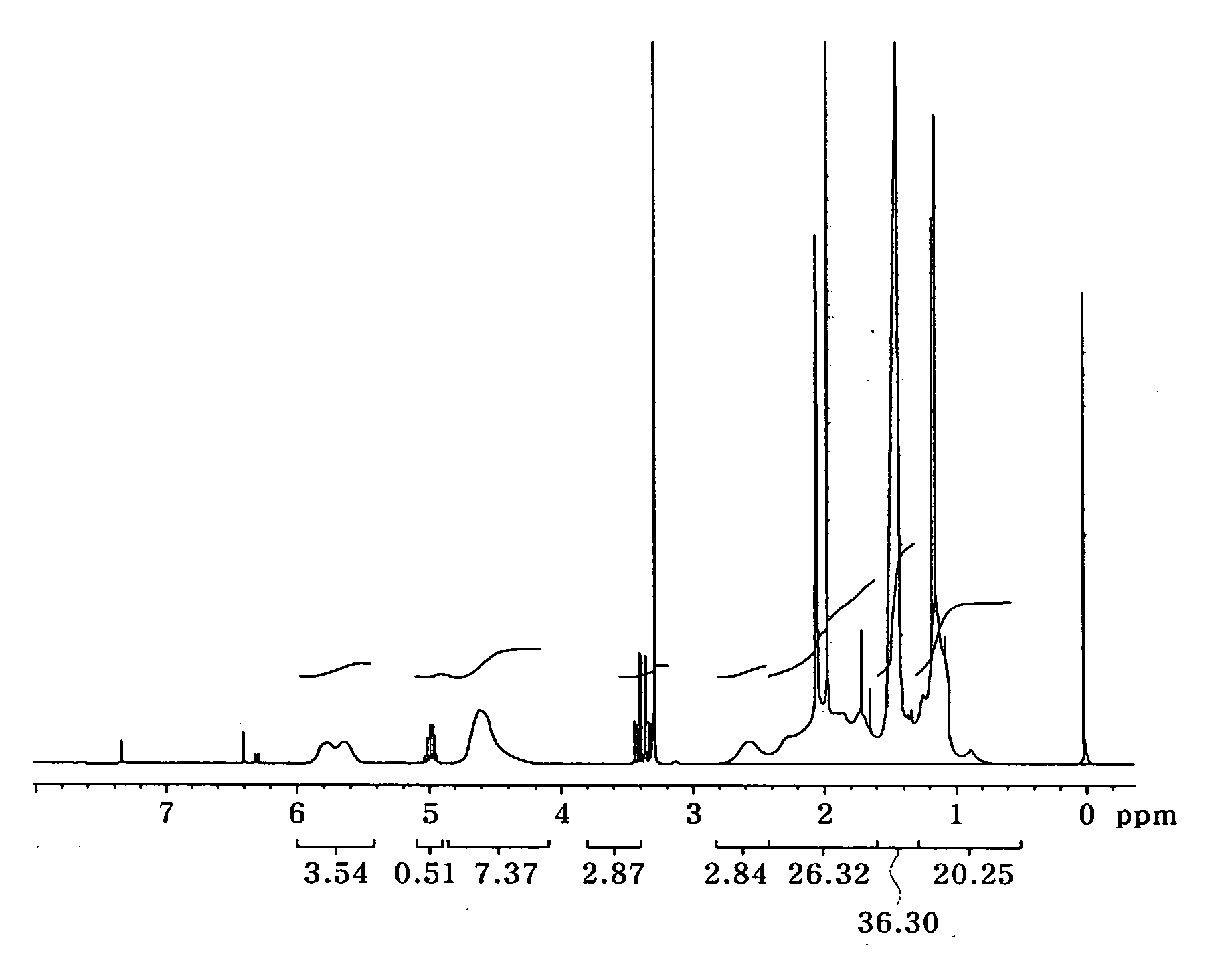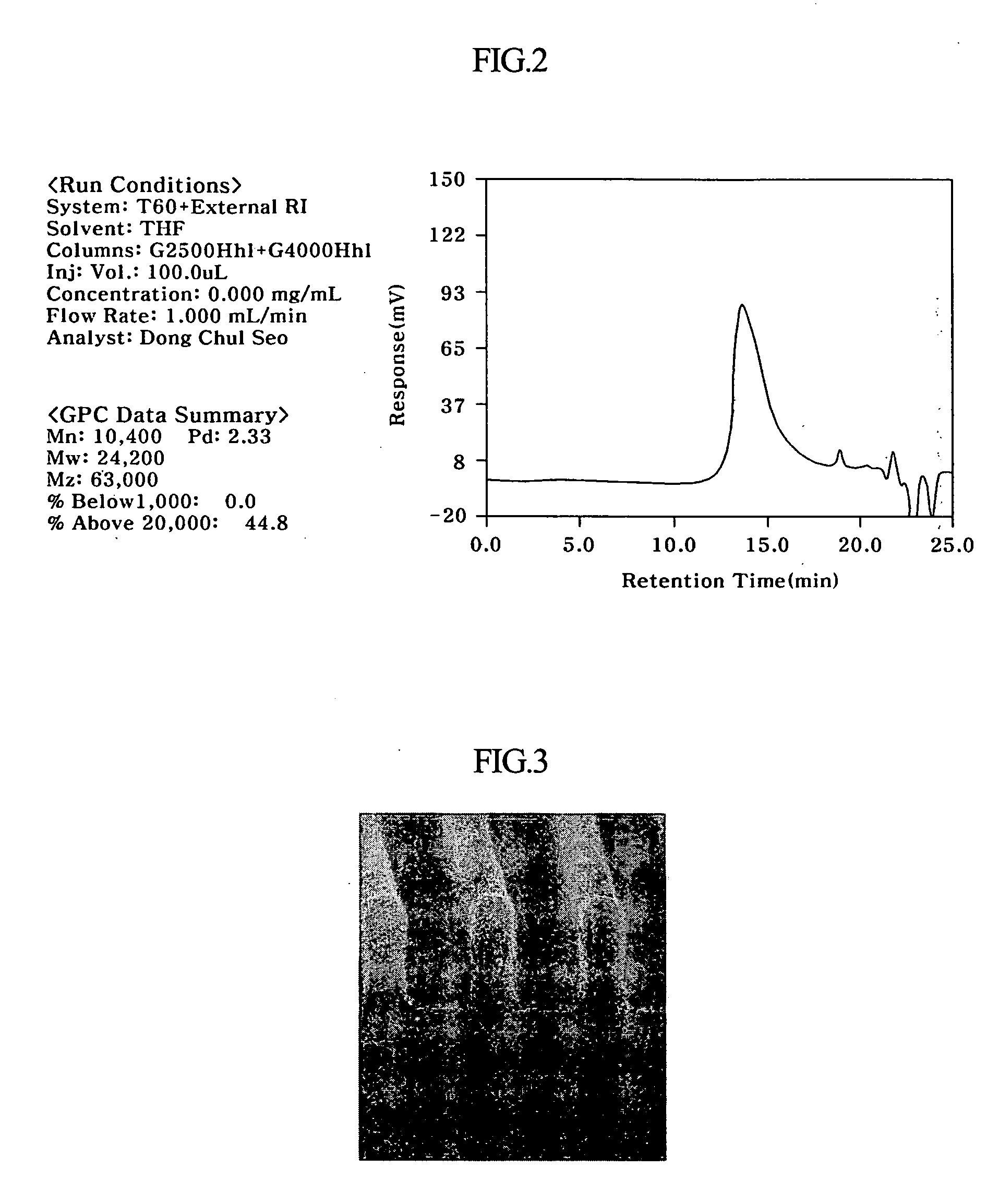Top anti-reflective coating polymer, its preparation method and top anti-reflective coating composition comprising the same
a technology of anti-reflective coating and polymer, which is applied in the direction of auxillary/base layers of photosensitive materials, instruments, photosensitive materials, etc., can solve the problems of high-quality caf/sub>2/sub>, short life of light sources, and high production costs of hard pellicles
- Summary
- Abstract
- Description
- Claims
- Application Information
AI Technical Summary
Benefits of technology
Problems solved by technology
Method used
Image
Examples
example 1
Preparation of a top anti-reflective coating polymer: poly(t-butylacrylate-methacrylic acid-2,2,3,4,4,4-hexafluorobutyl acrylate-N-[(perfluorooctanesulfonyl)oxy]-norbornene-2,3-dicarboximide-maleic anhydride)
[0050] 0.5 g of N-[(perfluorooctanesulfonyl)oxy]-norbornene-2,3-dicarboximide, 0.5 g of maleic anhydride and 0.4 g of AIBN were dissolved in 10 g of acetone. The monomers were polymerized at 67° C. for 30 minutes. To the polymerization product were added a solution of 2.5 g oft-butylacrylate, 2.5 g of methacrylic acid and 5 g of 2,2,3,4,4,4-hexafluorobutyl acrylate in 40 g of acetone. The mixture was polymerized for 6 hours. After completion of the polymerization, the polymerization product was precipitated in water, filtered, and dried in a vacuum to give poly(t-butylacrylate-methacrylic acid-2,2,3,4,4,4-hexafluorobutyl acrylate-N-[(perfluorooctanesulfonyl)oxy]-norbornene-2,3-dicarboximide-maleic anhydride) in a yield of 68%. The structure of the polymer was identified by 1H-N...
example 2
Preparation of a Top Anti-Reflective Coating Composition and Pattern Formation
[0051] 1.0 g of the poly(t-butylacrylate-methacrylic acid-2,2,3,4,4,4-hexafluorobutyl acrylate-N-[(perfluorooctanesulfonyl)oxy]-norbornene-2,3-dicarboximide-maleic anhydride) prepared in Example 1 was dissolved in 60 g of n-butanol to create a top anti-reflective coating composition for immersion lithography.
[0052] A photosensitizer (AR1221J, JSR) was coated to a thickness of 200 nm on a wafer, and baked at 130° C. for 90 seconds. The top anti-reflective coating composition was coated at 3,000 rpm on the coated photosensitizer. To confirm whether the top anti-reflective coating composition of the disclosure can function as a protective film of the photosensitizer against water after the coating, the wafer was immersed in water for 3 minutes. After exposing the wafer to light using ArF exposure equipment, the exposed wafer was baked at 130° C. for 90 seconds and developed to form a pattern. An image of th...
PUM
| Property | Measurement | Unit |
|---|---|---|
| refractive index | aaaaa | aaaaa |
| refractive index | aaaaa | aaaaa |
| thickness | aaaaa | aaaaa |
Abstract
Description
Claims
Application Information
 Login to View More
Login to View More - R&D
- Intellectual Property
- Life Sciences
- Materials
- Tech Scout
- Unparalleled Data Quality
- Higher Quality Content
- 60% Fewer Hallucinations
Browse by: Latest US Patents, China's latest patents, Technical Efficacy Thesaurus, Application Domain, Technology Topic, Popular Technical Reports.
© 2025 PatSnap. All rights reserved.Legal|Privacy policy|Modern Slavery Act Transparency Statement|Sitemap|About US| Contact US: help@patsnap.com



